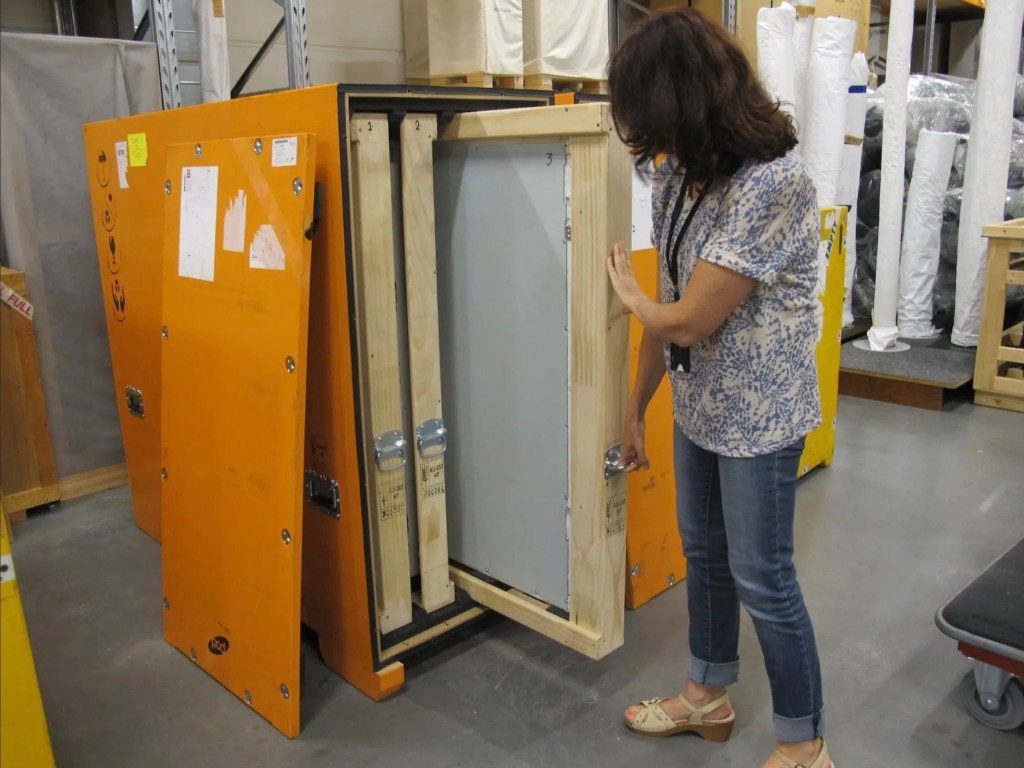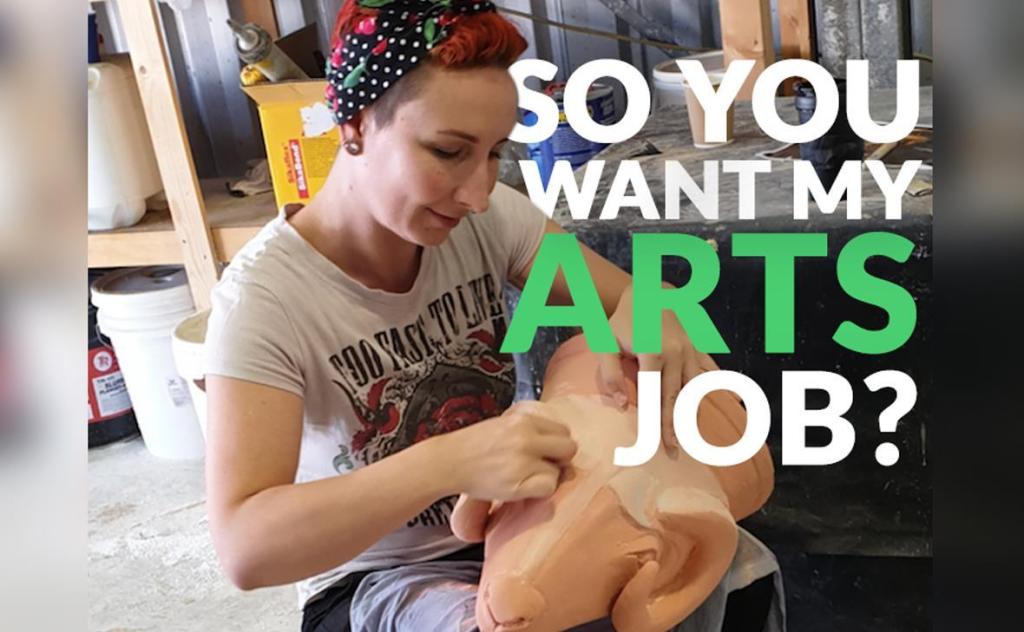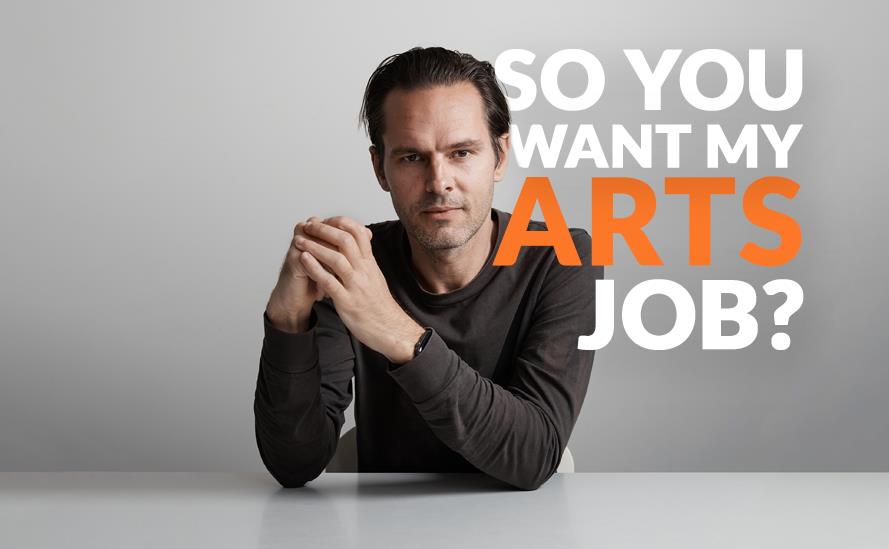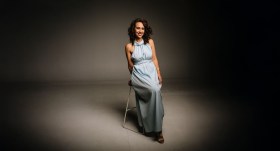BEHIND THE SCENES
We are not all geared to take the helm of an organisation or be on the front line, on the mainstage or chasing the constant sell as a freelancer. Here are some jobs better suited to careers that contribute solidly to the end product, from behind the scenes.
‘I prepare artwork and other culturally significant material for storage, exhibition and loan, and assist with exhibition/display installation,’ describes Andrew Hawley of his role as Collection and Exhibition Preparator at Hobart’s Museum of Old and New Art (Mona), which is known for their eccentric and challenging exhibitions. He added that a large part of the job is also designing and fitting out custom packing units for artworks, and works closely with registrars, conservators and other technicians.
If you love theatre, but being on the mainstage is not your thing, then maybe a theatre technician is your gig. At La Boite Theatre, Jono Harrison describes his role as the company’s Technical Coordinator as being responsible for all technical elements, including lighting and sound. He continued: ‘I might mix some live musicians in the morning, design and program lights for a dance show in the afternoon, and test projections in the Forecourt at night.’ This also involves maintaining the venue and improving infrastructure at La Boite, he added.
If you have a keen eye for colour, materiality and space, then being an exhibition designer might be the job for you, according to the National Gallery of Australia’s Jing-Ling Chua. ‘You also need technical drawing skills and the ability to convey design concepts through models, drawings or 3D renders. Being a good listener helps, as we take on board the specialist needs of the exhibition team and give them form to shape the experience of the visitor,’ she added.
While being a program coordinator may sound like a position of pure glamour to some – galas, openings, champagne… Matt Warren explains how his love of community, volunteering and education helped secure his job at The National Portrait Gallery. He added: ‘My current role is more about finding pathways into the collection for various audiences, and developing and delivering experiences that increase public awareness of and love of the NPG.’
Globally only three percent of literary works published in English are translations from other languages, according to Elizabeth Bryer, a literary translator who works from Spanish to English. She added: ‘Translation allows a much wider range of voices to be heard,’ she continued that while you need to know at least two languages to translate, ‘you need to be able to empathise with the voice of the work and enter a creative dialogue with the author.’
‘A book cover is a collaborative exercise,’ said Text Publishing’s design director WH Chong. As a founding member of the Australian Book Designers Association (ABDA) he said most people have no idea what the role entails. ‘[It’s] complicated by a lot of concerns: there’s the editorial concern about the book written, there’s a marketing concern about how it will work out in the world, there’s a publishing concern about how this object will forward the book, and there’s a legacy concern about how the cover will sit within all that we know about book covers. There are a lot of conventions that you have to be familiar with. Unless you know what a book’s going to do in the real world, you’ve got nowhere to begin, because there’s just a little rectangle and you can put anything you want in it.’ Sounds fun?
Casting directors might be the first person a performer meets to discuss a role, but they don’t make the call on who gets the job, according to Lauren Mass. If she was looking to recruit someone for her role, she’d be looking for someone who works well collaboratively. ‘This industry is all about working with others. From concept to auditions, and beyond, there are so many people and wonderful brains at work through every step of the process that you really need to be a team player. Teamwork, and understanding that not everyone may approach a task the same way, is vital,’ said Mass.
From inhabiting dialects to teaching actors to croak like a pelican, Charmian Gradwell’s job as Sydney Theatre Company’s Voice, Text and Dialect Coach is a fascinating one. She’s helped Cate Blanchett master a Mississippi drawl and taught Bruce Spence to bark like a dog. Offstage she’s worked as the dialect coach on films including Peter Rabbit, Thor: Ragnarok and Pirates of the Caribbean: Dead Men Tell No Tales. She adds of her job: ‘Keeping the actors vocally safe throughout the rigors of rehearsal and performance and expanding the vocal range whilst safely navigating the mechanics of other vocal demands’ is key.
Read: How long should you stay in a job?
MAKING A DIFFERENCE
The arts give much to community and audiences, from mere entertainment to aspects of wellbeing. While many of us are in the job of producing those products or managing venues and organisations that deliver, for others the desire to drill deeper into the social justice and care aspect of the arts is appealing as a career.
As a creative learning expert, Rose Downie is passionate about empowering young people to think creatively through her work at Sydney Children’s Hospital. Her role is to coordinate and facilitate art experiences for sick kids and their siblings. These workshops allow kids to relax and enjoy the process of art making in Sydney Children’s Hospital School, on the wards and by their bedside. ‘As part of my job, I also invite local artists in to work with the children,’ added Downie.
An audio describer is a media access professional who translates visual imagery into verbal information for the benefit of people who are blind or have low vision. As founder of Description Victoria, Will McRostie explained that her job is about interpreting and presenting the arts – anything from exhibition tours, special events, panels and conferences, circus and dance – to create a bunch of resources for easy access.
With theatre, ‘we’ll write a script that fills in gaps in the dialogue, scene changes and any other available pauses with a verbal description of the visual things that are happening on stage. We’ll produce pre-show notes with detailed descriptions of the set, characters and costumes. And we’ll run a tactile tour, inviting audio description users up onto the stage with the stage manager and hopefully some of the cast to have a walk around, orient themselves, touch the sets and costumes and props, so people have a deeper understanding of the layout of the stage and some of the visual effects used in the show,’ she explained.
As an arts lawyer, Roxanne Lorenz helps artists and creators to understand and protect their rights. The job requires an ability to convey complex legal concepts, attention to detail, a lot of reading and most importantly, a passion for the arts.
Art therapy is the perfect career for those who believe the journey of creating art is more important than the destination. Art therapy was first recognised as therapeutic tool in the 1940s. Since then it has been inceasingly acknowledged as a powerful way to improve both mental and physical well-being. Art therapy focuses mainly on the process of making art, rather than what is produced. Bel Ryan, art therapist in Paediatric Palliative Care at Adelaide Women’s and Children Hospital and director of her own private practice Ignite Art Therapies, gives ArtsHub readers an insight into the role.
SPECIALIST CAREERS

The arts are full of them – specialist careers – from paper conservators to glass gaffas. If you have a passion for something in particular then you are likely to find a way to nurture it within the arts.
In simple terms, Olivia Fuller helps artworks find new homes. Delving into the world of art auctions involves conducting valuations for art collections, researching fresh to the market pieces, curating an auction to bring out its highest potential, as well as standing on the auction block, gavel in hand, ready to congratulate the highest bidder. Fuller was promoted to the Head of Fine Art at Leonard Joel in 2019 and has since then pioneered the auction house’s annual Centum Contemporary Art auction, as well as their Women Artists auction. ‘Being able to see an artwork through from start to finish is one of the most rewarding aspects of my job,’ she told ArtsHub.
Catherine Polcz is the Science Program Producer at the Museum of Applied Arts and Science (MAAS) – more specifically, Powerhouse Museum and Sydney Observatory – a job she describes as creating experiences for audiences including exhibitions, science festivals, livestreams and programs. So if you have a passion for sharing the wonders of the world, be it a starry sky, ancient relics, or helping people feel comfortable with contemporary art, then thinking around ideas and making them accessible is the job for you.
NGV’s Curator of Fashion and Textiles Danielle Whitfield said the greater misconception of her job is attending front row fashion runways. Rather it is a very hands-on (though not try-on) experience of bringing century-old historic gowns to life via exhibitions. Seeing fashion as part of culture both past and present, Whitfield invents creative ways to communicate a medium that is so familiar to us, but one that also captures awe and wonder at the same time.
The publishing industry is more than just editors and publishers – in fact, it’s more than just books. When asked to describe her job as rights manager for Allen & Unwin, Maggie Thompson says that her role is, in essence, managing ‘all the things you can do with a book that aren’t selling the book itself in Australia.’
Whether writing for an orchestra, an ensemble, or for the theatre, film or television, the composer’s art conveys emotion through music – enhancing existing drama and conjuring the sublime. But how does one start as a composer – is it the sort of career you stumble into, or a calling felt from an early age? Three composers reflect on the influences and events that shaped their careers and offer advice for those following in their footsteps.
Sydney based Art Advisor Mark Hughes said that this job is perfect if you love working with art but don’t want to be tied down to a traditional gallery system. Also known as an Art Consultant, the primary role is to help ease private and corporate clients through the quagmire of the art market, be it visiting art fairs, galleries or studios and to build confidence in their decisions. ‘Simply, they are hiring you for your professional knowledge. As an art advisor you are helping to focus their interests, educating them on artists, and then ensuring they have access to the work with a budget,’ Hughes said.
Conservation for many is a mysterious department in a museum or art gallery, part-science lab, part-research library, part collection-holding and registration area. We can’t help but conjure images of the popular television series CSI – all white coats, latex gloves, and wow moments. But Debbie Ward, Head of Conservation, National Gallery of Australia (NGA) sets us straight on what sits behind the high security door. ‘We like the drama of finding something, like “Wow there’s a whole other painting under this painting…People don’t usually start conservation and then abandon it,’ said Ward.
The movement and handling of artworks is a fascinating and specialised field, and one that is not learnt through a degree. The registrar in a cultural institution implements the policies and procedures for the storage, packing, and movement of artworks and objects. This is generally divided between the museum’s own collection and those artworks temporarily coming into the gallery for exhibition, and is a role that is usually split in larger institutions into two separate jobs. Most registrars come to the role with some arts or arts management background and then move their way up the field through experience accrued on the ground. Today it is an exciting and dynamic role – and one that allows you to get your hands on the world’s art treasure – oh, gloved of course!
HANDS ON ARTS JOBS

Are you the more physical kind, attracted to seeing something emerge in the studio with lots of hard work, a dose of love and a good bit of grunt? Then here are some hands on jobs to bring in some dollars while staying creative.
Film prop maker, Hannah Crosby busts some of the myths about making artwork for the silver screen – the props we have seen on films such as Thor: Ragnarok, Aquaman, Dora: The Lost City and Kong vs Godzilla. She said that the greatest misconception is that all roles within props are creative. ‘While there are some roles which will allow you to be part of the design process, like concept artist or designer, many roles are very process and management driven.’ Crosby did the Props and Objects course at NIDA to build her practical fabrication skills. Her advice: ‘Establishing yourself as a reliable and skilled person within a group of other professionals who enjoy working with you will ensure you’re on the list of key people for them to hire for the next production.’
‘I gave up telling people I was a fight director years ago, because people would automatically interpret the word “fight” as “flight” and then I’d be fielding questions about what it was like to fly an aeroplane,’ said Nigel Poulto, an award-winning, internationally renowned fight director, weapon and movement specialist, stunt performer and actor. He also works in Intimacy Directing … also hard to explain, he added with a laugh.
While the reality TV show Blown Away may have popularised glass blowing and the ‘hotshop’ as a creative space for contemporary artists, glass has been around for centuries, moving between the realms of fine exhibition work and production. Annette Blair explains: ‘I’m a glassblower, but there’s much more to it, as any small business operator knows. When I’m in the studio I’m a glassblower, designer and artist and I do all the necessary business and arts admin when I’m not.’ She also works as a gaffa for other artists who hire her to make elements for their artworks or commissions.
Circa ensemble member, Billie Wilson-Coffey, has performed all over the world in festival and cabarets. She explained of contemporary circus: ‘Most often I work in a group of seven or eight acrobats, spending many hours of my day climbing on people or climbing two pieces of material, also known as aerial silks. While I enjoy the creation process of shows, it is performing on stage where I really feel elated.’
If you can think laterally, are persistent, accurate and skilled at sewing and sculpting, becoming a puppet-maker might be the career for you. Puppeteer Tamara Reese explained: ‘I make puppets, perform with puppets and teach others how to make or work with when I get the chance… It’s pretty varied,’ adding that it is a ‘whole new world for a crafty performer type! I have been making puppets for over 20 years and it still stretches my brain!’
If you have an ear for detail, an active imagination and technical know-how, working as a sound designer and composer might be the job for you, said Daniel Nixon. He describes what he does as ‘supporting the telling of stories. I create sonic content designed to enhance the experience of seeing a story unfold.’ As a composer, sound designer and multi-instrumentalist, he has performed with the MSO, Orchestra Victoria, John Farnham, Yothu Yindi, Sebine Meyer and many others. He has also scored and designed numerous films, games, ads, plays and dance works.
FREELANCE FLEXIBILITY

Do you struggle with working under the wrath of others and prefer to manage your own day, your own career drive and expectations … and your bank balance? Then here are a few freelance and gig careers that might be your dream path.
Freelance arts writer and editor
Doug Wallen is a freelance writer and editor who regularly publishes with titles such as The Big Issue, The Australian, Broadsheet, The Guardian and beyond. He started out as an editor at several community newspapers in America before moving into an Editor role for The Big Issue. He views freelancing as being ‘lucky to write about things I enjoy: music, books, cocktails and food. That might mean reviewing an album or interviewing a chef, depending on the day. My outlets range from magazines and newspapers to websites and streaming platforms, and I moonlight as an editor, subeditor and copywriter. I also write band bios, do some freelance PR, book a lot of gigs, and host a weekly radio show.’ In other words, if you are motivated the work can be broad and fulfilling.
Daniel Boud has photographed celebrities from Flume to Cate Blanchett and Ai Wei Wei, and has worked with most major Australian arts companies. He said to make a career out of photography, ‘you need to really be focused on fulfilling your clients’ needs. As much as what I do is creative and artistic, I think of myself as a tradesperson, fixing problems for clients and focusing on customer service.’
David Astle has been setting Crosswords for The Age and Sydney Morning Herald for 35 years and describes himself as a self-confessed word nerd. He said the greatest misconception is that, ‘The hard part is fitting in the words. Hah! A two-bit computer can do that for you, if you’re feeling lazy. But what software can’t match is the sneaky clue, where definition dovetails with wordplay in a fresh and misleading way. That takes hours of daydreaming and fine-tuning, setting the brain-trap just right.’
LEADERSHIP DREAMS
When you have no conception of a glass ceiling, of a ladder to climb and your blue sky dreaming is grounded in reality and ambition – then you are destined to be leading our sector. Here are a few careers that take the helm.
If you can balance strategy, business and networking with creative inspiration, then working as an artistic director might be the job for you, Shaun Parker explains. ‘The majority of people think that my job is just art, fun and creativity but in truth, I do an awful lot of strategy, business and networking – creating performance is very minimal in comparison to everything else going on. There’s an awful lot more work behind the scenes than I think people realise,’ he said.
Theatre Works’ Dianne Toulson said she is only as good as her team. ‘Collaboration within the team is vital to arts organisations. It can be challenging and hard work. So of course, capacity to communicate is the most vital piece of the puzzle for a GM. I believe every person brings their own element of experience and value to a role and that everyone is different.’
Producer (Festival)
If you’re organised, a good listener, good humoured and comfortable sitting with fear, being a producer might be the job for you, according to Perth Festival’s Anna Kosky. She continued: ‘My role encompasses things like program development when we’re in the planning phase. I work with the Artistic Director, Executive Producer, Program Associates or Creative Leads to test the viability of ideas, whether that be from a financial, logistical or from a creative rigour point of view. It then moves into project planning to build the critical paths and budgets, and then of course to the fun bit (most days!) delivering the events and being on the ground.’ She added: ‘I sometimes think of the Producer as the bus driver. You have all these people in a bus (the project team) and you’re the one who’s got the foot on the accelerator moving everything along, sometimes doing singalongs, sometimes pointing out things, checking for potholes and one-way streets but also always keeping an eye on the horizon for any storm clouds that may prove ominous.’
Being a director of an Artist-Run Initiative (ARI) is extremely collaborative, says Rebecca Gallo, an artist and founding member of Pari, in Sydney’s West. ‘It’s been important for us to have a group with a range of skills and experience. We all need to be flexible, self-motivated, patient and willing to try new things. Some take on more of a mentor or mentee role, some work on particular jobs more independently, and others collaborate across a number of projects. Finding folks with skills and interest in administration and finance has been a challenge, but extremely important!’
While online material has changed what librarians do, they’re specific knowledge and skillset can certainly never be replaced, describes Hayley Webster, Library Manager of Museums Victoria. She said the role is suited to someone who has broad experience, ideally in a special library context, and someone who is adaptable, as the role requires someone who can quickly respond to changing organisational requirements and priorities. The role is incredibly fulfilling and covers a raft of knowledge areas, plus pushing against misconceptions is very much alive from new research technologies with rare books, to digitisation programs, to rethinking how we engage with libraries in our contemporary times.





